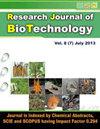风疹帽菌中 WRKY 超家族的硅学鉴定和特征描述
IF 0.2
Q4 BIOTECHNOLOGY & APPLIED MICROBIOLOGY
引用次数: 0
摘要
植物在其整个生命周期中会经历多个过程,如生长、发育和对环境胁迫的反应,这些过程需要一系列由转录因子调控的信号事件。WRKY 是研究最多的转录因子之一。在这项研究中,我们分析了风信子中 WRKY 超家族的 68 个基因。研究了所有基因的植物化学特性,包括分子量、氨基酸数量、理论 pI、N-糖基化位点、保守基序和同源模型。此外,还利用 MEGA6 软件建立了各物种之间的系统发育关系。理化性质表明,氨基酸数目从 149(可能的 WRKY 转录因子 45)到 1411(抗病蛋白 RRS1)不等,分子量从 17.28(可能的 WRKY 转录因子 45)到 159.39(抗病蛋白 RRS1)不等。根据亚细胞预测,所有蛋白质都被预测定位于核区。此外,68 个 WRKY 蛋白的系统进化关系分析表明存在一个主要支系和一个次要支系。在使用基于网络的软件工具 MEME 进行的保守结构域研究中,发现动点 2 是高度保守的,因为它存在于所有品种中,而动点 10 则是最不保守的,即仅在 4.41% 的品种中发现。我们的研究结果为今后在植物生物技术领域开展风信子胁迫相关研究提供了一个框架。本文章由计算机程序翻译,如有差异,请以英文原文为准。
In silico Identification and Characterization of WRKY Superfamily in Capsella rubella
Plants undergo several processes throughout their life cycle such as growth, development and response to environmental stresses which require a series of signaling events regulated by transcription factors. WRKY is one of the most studied transcription factors. In this study, we analyzed 68 genes of WRKY superfamily in Capsella rubella. All the genes were studied for their phytochemical properties which include molecular weight, no. of amino acids, theoretical pI, N-glycosylation site, conserved motifs and homology modeling. A phylogenetic relationship was also established among the accessions by using MEGA6 software. The physiochemical properties revealed the no. of amino acids ranging from 149 (Probable WRKY transcription factor 45) to 1411 (disease resistance protein RRS1) while the molecular weight varies between 17.28 (Probable WRKY transcription factor 45) to 159.39 (Disease resistance protein RRS1). Based on subcellular prediction, all the proteins were predicted to be localized in the nuclear region. In addition, the 68 WRKY proteins analyzed for phylogenetic relationships had shown the existence of one major Clade and one minor Clade. In conserved domain study using web-based software tool MEME, Motif 2 was found to be highly conserved as it is present in all accessions while motif 10 was found to be least conserved i.e. found in only 4.41% accessions. Our result provides a framework for future stress related studies in Capsella rubella in the field of plant biotechnology.
求助全文
通过发布文献求助,成功后即可免费获取论文全文。
去求助
来源期刊

Research Journal of Biotechnology
BIOTECHNOLOGY & APPLIED MICROBIOLOGY-
CiteScore
0.60
自引率
0.00%
发文量
192
期刊介绍:
We invite you to contribute Research Papers / Short Communications / Review Papers:
-In any field of Biotechnology, Biochemistry, Microbiology and Industrial Microbiology, Soil Technology, Agriculture Biotechnology.
-in any field related to Food Biotechnology, Nutrition Biotechnology, Genetic Engineering and Commercial Biotechnology.
-in any field of Biotechnology related to Drugs and Pharmaceutical products for human beings, animals and plants.
-in any field related to Environmental Biotechnolgy, Waste Treatment of Liquids, Soilds and Gases; Sustainability.
-in inter-realted field of Chemical Sciences, Biological Sciences, Environmental Sciences and Life Sciences.
-in any field related to Biotechnological Engineering, Industrial Biotechnology and Instrumentation.
-in any field related to Nano-technology.
-in any field related to Plant Biotechnology.
 求助内容:
求助内容: 应助结果提醒方式:
应助结果提醒方式:


